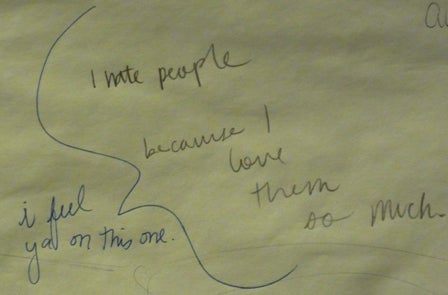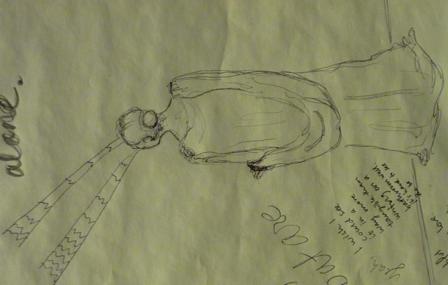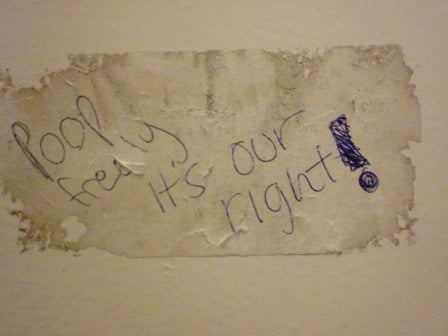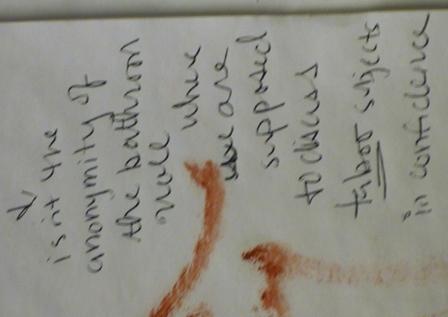American Graffiti
Tess Yanisch ’13
This week's blog is basically an update on last week's entry, meaning this time you get actual excerpts from my report-in-progress and more pretty pictures of bathroom graffiti. (If you're wondering what the heck I'm talking about, please check out the link above--that will tell you the basics.)
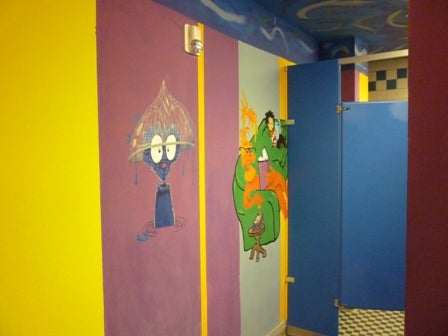
I did count up all the graffiti in each restroom and organize it all by hand into fairly organized tables, which I then re-created on my computer into precise, clean, very organized tables. The original plan had been to dig out my old notes from A.P. Statistics class (there are times that being a packrat is useful) and describe any statistically significant differences between colleges or where the restroom was (library/dining hall/student union). However, I then realized that I didn't have just tons of data--yes, it was a lot to transcribe, but statistically speaking, 611 graffiti isn't much. While I might have gotten statistically significant results, they may not have actually meant anything. So I'm being a trifle less scientific and spending my time more on content analysis, with a little speculation about the numbers. I actually quite like how the project is turning out. Here's a sneak preview.
Why write in bathrooms? Alan Dundes (the originator of the term latrinalia) suggests a rather Freudian origin for the urge to write while on the toilet, invoking infants' tendencies to play with their feces and "womb envy" in men as the driving forces behind creative expression and the desire to leave an enduring mark of one's presence (Dundes 370-373). I, however, had doubts about this theory--for one thing, I discovered that women create plenty of latrinalia, despite actually having wombs. Much of Dundes' theory is also based on the fact that he found more latrinalia in men's bathrooms than in women's, and Dermakardijian cites multiple sources who imply that women's latrinalia has become more prolific since the sixties, so that it now equals or surpasses men's in quantity (Dermakardijian 6-7). As her study seemed to be more up-to-date, I chose to rely on it more heavily for explanations.
I did observe a heavy influence of the feminist-critique style in Dermakardijian's thesis, which I tried to avoid most of the time. Like me, she examined only women's restrooms, and her thesis centered around the idea of the restroom as a women-only sanctuary from a largely male-dominated world. (In the abstract, she writes, "For women, who often struggle to speak in outside situations which are dominated by the latent but unavoidable masculine voice, the gender-specificity of the site allows them even more freedom.") This could very well be accurate, but I attempt to place less stress on gender in my piece for several reasons. First, I am only a freshman with little to no formal background in feminist theory. Second, Dermakardijian was studying at Stephen F. Austin State University in Texas, a large public university that (judging from the content of the latrinalia and the student body demographics she lists) has a more traditional atmosphere than U.P.S., Oberlin, or Reed, which could mean her findings apply better to the former school than the ones I studied. Finally, I made a conscious decision to view the latrinalia I'd collected as snatches of people's thoughts and evidence of a social exchange, and, while the fact that the individuals in question were all women is noteworthy, it does not explain everything--gender is not the entirety of personality. (All these people were also going to small, expensive, academically rigorous, politically liberal schools, for instance.) Besides, according to a graffito found in the Reed student union bathroom, at least one of the bathroom users identified as male (Yes, I have a vagina And yes, I'm a real fucking boy). However, this was also probably unusual enough that women would treat restrooms in general as safe places for topics they would not feel comfortable discussing around men, and I endeavor to remember this possible impact on the subject matter.
However, Dermakardijian, too, calls upon the link between excretion and unburdening the mind. The subversion of authority inherent in graffiti (which is technically vandalism) coincides, in the restroom, with the violation of other taboos around bodily functions. Since everyone transgresses equally in that respect, social hierarchies can be dissolved as well, permitting graffitists to address anyone in the stall as an equal in an anarchistic "animal state." Perhaps carrying out the private act of elimination in a somewhat public place drives the women to similarly leave a sign of their private thoughts where others can read them. "This emotional waste is clearly visible in women's latrinalia, as their thoughts, desires, and emotions cover the walls" (Dermakardijian 27). A similar sentiment emerges during an exchange in the Reed library:Why do so many people shit w/ pens?To write on the walls. It's a well-known cure for constipation--literal AND figurative.
Furthermore, the bathroom is a safe place to write in general. Dermakardijian suggests that "Each of the graffiti conversations takes place because the bathroom offers conditions that simply cannot be found elsewhere" (74). A key component of this atmosphere is anonymity--students may write whatever they wish, however socially unacceptable it may be, and not be ostracized because of their statements. The writers seem to be well-aware of this, particularly at the types of colleges surveyed: many of the students have probably taken classes in the social sciences themselves and are likely very aware of how their surroundings may affect their communication styles. A student at Reed addresses this directly, demanding, "isn't the anonymity of the bathroom wall where we are supposed to discuss taboo subjects in confidence[?]" As Smelko says, "Social judgments can be reserved for the words alone, yet not be tracked to the author with accompanied biases . . . When written in a restroom stall, the message is presumably being communicated privately; yet it is inevitably designed for public consumption because the restrooms on campus are technically public and open to everyone" (1).
Thus, personal thoughts can be shared, yet the connection is made at a remove. The usual pattern of discourse is inverted: the original graffitist and her audience connect from exactly the same place but with a considerable difference in time (whereas, in a regular conversation, the participants talk from different places simultaneously). The sharing is physical, not temporal--the audience will view the latrinalia through a veil of time and anonymity. Such a veil protects both the writer and the reader, especially if the reader is moved to respond.
Debates may rage without serious emotional damage to any of the parties involved or any evident social stress beyond a few scrawled remarks on a bathroom stall door. Even relatively minor issues can draw heated debate, as this exchange in the Oberlin student union makes clear.All written on a "Dry your hands on your pants" sticker: BULL yeah--that's sanitary! --might as well not wash @ allgermaphobic. Let's not touch anything: might be unsanitary!
why? Do you have urine on your pants?
Urine is sterile
pants are notif urine is sterile, why wash our hands?
It is unlikely that students would express irritation with the sticker vocally: they would run the risk of being labeled as "germaphobic," or being accused of making too big a deal over what is, after all, only a sticker. Also, the topic probably would not come to mind anywhere but in the restroom, and social norms make it unlikely that anyone would feel comfortable discussing it vocally with a stranger in the bathroom.
This is another benefit of anonymity--it dissolves the social boundaries between people. "[P]articipants in bathroom graffiti span all social classes, and stand outside of imposed societal constraints" (Vamos 14). While two women might never meet as classmates or friends, they could exchange information and opinions on the bathroom wall and thus experience perspectives they would not otherwise be exposed to. One of the advantages of latrinalia over spoken conversation is the removal of certain restrictions from the social dynamic: speech "does not eliminate the problem of social hierarchies and positioning that could potentially stifle free expression" (Dermakardijian 21). For instance, the class, race, age, religion, sexual orientation, and family background of one graffitist are a complete unknown to the others, unless she chooses to divulge that information herself. Stereotypes and first impressions are no longer impediments to free discourse.
The cumulative effect of anonymity, then, is to remove both the writer's inhibitions and the reader's prejudices. This opens up an avenue for dialogue with people the graffitists might not otherwise interact with on subjects they might not otherwise introduce.
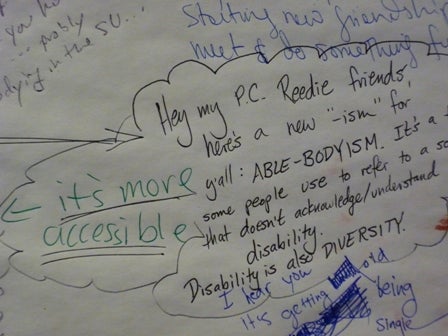
This is all just one subsection of the report (eek!). I'm learning things even as I write the paper: a connection will become apparent when I'm in mid-sentence and I scroll back up to a previous paragraph to re-arrange my ideas. In a nutshell, right now, my paper is about how writing on the bathroom wall is actually a social environment, full of interaction and discussion, which some people even use to get advice and social support. I'm seriously considering changing the title of the report to "The Original Chat Room."
As you can probably tell, I decided to go for a semi-formal tone--I am, after all, having fun, and this is not of huge importance to the social sciences. What I love about it, though, is that it's great practice for doing research that could be. I now know a little about collecting and organizing data, laying out a really long paper, contacting sites for permission to carry out my research, and so on. I also feel like I know what will take longer than I expect it to (everything!).

I suppose this is what Winter Term is all about: exploring something you're interested in, learning about the subject matter, learning how to learn. In a way, I've been putting on the hat of an independent researcher for the last month. The only way to learn to do something like that is by trying it, and now I have, in a manageable, low-stakes environment.

Whimsical, Completely Unrelated Movie Review: Sherlock Holmes
I finally saw the movie this week, and I quite enjoyed it. Of course, it deviates considerably from the tone of the books; this must be said up front. There's fighting, explosions, and a dive from a third-story window into the Thames, Sir Arthur Conan Doyle probably wouldn't recognize some of his creations (Irene Adler has been spiced up from "the only woman Holmes ever respected" into "the clever, daring criminal he won't quite admit to being in love with"), and London has taken a turn for the steampunk-ish (but in a tasteful manner).
However, the necessary qualities remain. Holmes is smart, moody, tightly-wound, and infuriatingly smug, with a dry, biting sense of humor, always ready to poke fun at anybody's failings--including (very occasionally) his own. He's still driven to solve cases not just for the mental exercise but also by a desire to see justice carried out. Watson is still somewhere between an excited, curious chronicler and a sane man wondering "how exactly did I get talked into this?"
Their relationship in the movie incorporates something that I'm surprised hasn't been touched on before: the fact that these two men, of very different personalities, have been roommates for several years. Consequently, they fight like an old married couple. "Your experiments are going to kill my dog!" "Our dog." "The dog!" Or, at the very beginning, "Where's your revolver?" "Ah. Knew I'd forgotten something. I thought I'd left the stove on." "You did." Of course Watson is engaged, and Holmes isn't entirely happy about him moving out (on some level, he seems to realize that he needs someone to keep him relatively grounded), and meanwhile, the man he's just put in prison for murderous arcane rituals has apparently risen from the dead . . .
The touch of the supernatural at first threatens to turn the film into a period-piece fantasy action movie, but logical explanations emerge in the end. This isn't entirely unlike the books--some of them are scary until Holmes figures out it's all smoke and mirrors put on by the disgruntled younger cousin's fiancee's hairdresser's mother.
The high points:
- Clever dialogue (especially Holmes being infuriating)
- Fun soundtrack--especially the bouncy fiddle music
- Interesting plot--keeps you guessing
- Half-built bridge across the Thames (whenever there is a half-built bridge in a movie, the characters must fight on it, make out on it, or fall off it; this movie is no exception)
- Robert Downey Jr. shirtless

Tags:
Similar Blog Entries
What is Winter Term?
A condensed guide to your most commonly asked questions about Winter Term.

Mi Viaje Maravilloso a Guadalajara - Part 3 ¡y adiós!
The third and final installment in the story of my second Winter Term trip to Guadalajara, Mexico, focusing on the cultural excursions and the community ties I'll carry with me.

Mon Voyage Magnifique à Bordeaux - Part 4 and Goodbye
Part four of a review of my magnificent trip to Bordeaux, France, focusing on the cultural excursions, the community, and my takeaways.

